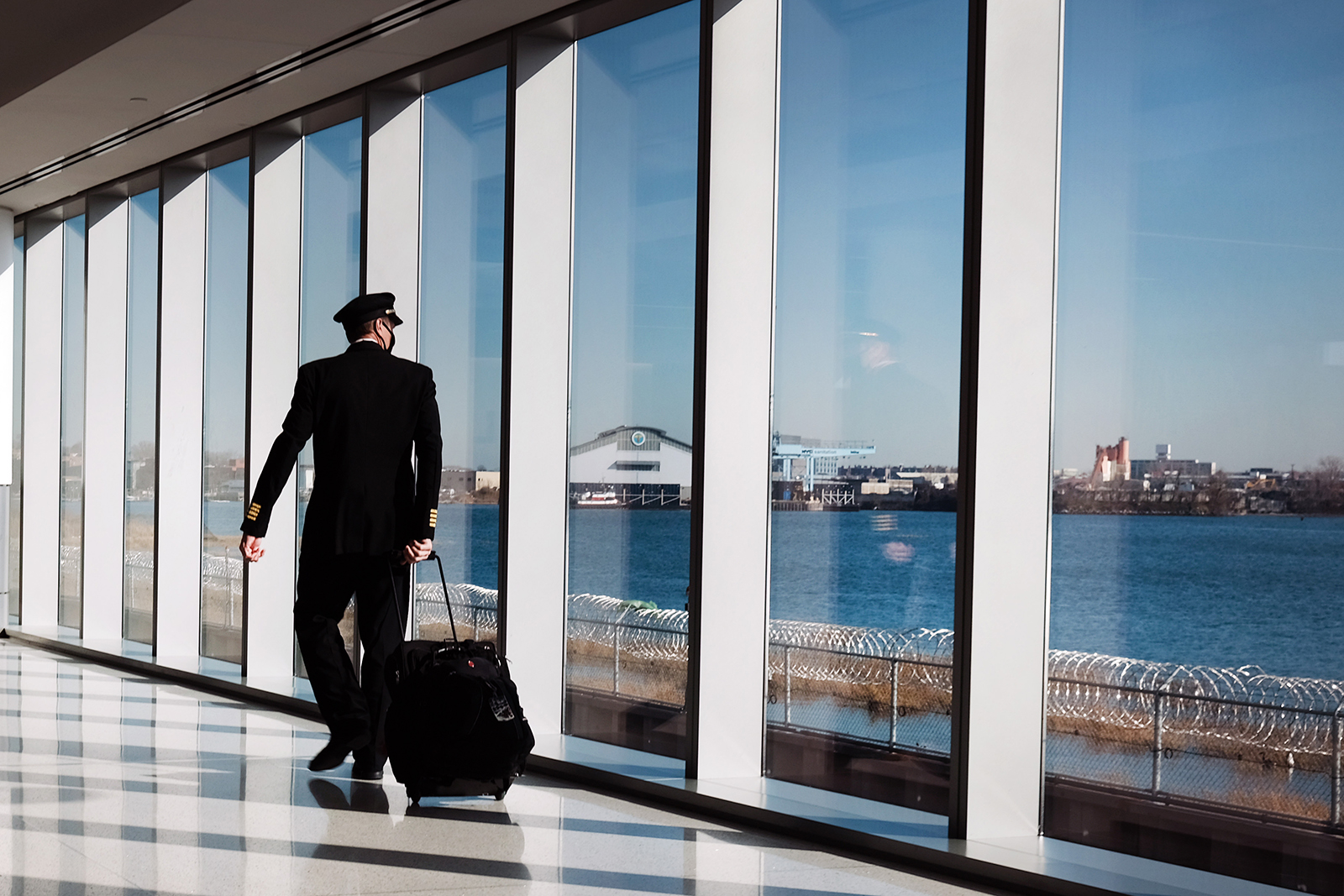North American Aviation Enters 2023 With Too Few Pilots and Mechanics

A pilot walks through New York's LaGuardia Airport. A commercial airline pilot shortage in North America is leading to cutbacks in service to less popular destinations.
Photo: Spencer Platt/Getty Images
In 2022, there were already too few commercial airline pilots in North America, leading to cutbacks in service to less popular and more rural destinations and a contraction of regional jet operations that had lost pilots to major airlines.
This year, there are also too few mechanics.
Oliver Wyman projects a gap in 2023 between the North American supply and demand for mechanics of more than 12,000. This estimate takes into consideration the number of licensed and unlicensed labor working on aircraft and in repair shops as well as the anticipated demand for maintenance, repair, and overhaul (MRO) services. The gap represents about 14% of the total workforce of mechanics, which are often referred to as technicians in the industry because of the advanced, highly skilled nature of their work.
In fact, the aviation industry in North America enters 2023 with too few workers in many job categories, including air traffic controllers and ground crew. In the case of both pilots and mechanics, the gaps between supply and demand cannot be filled overnight because of the training required and a limited pool of prospective technician candidates.
Industry Efforts to Close the Gaps
But, over the past year, airlines have been working hard to address the various shortages. For instance, besides cutting back on service, airlines also tried to lure pilot candidates by increasing salaries — significantly in the case of regional airlines — and providing faster paths to career advancement. Awareness of the impending, decade-long shortage itself also ended up helping attract pilot candidates, giving them new confidence in the potential for long-term job security in what has been at times a boom-and-bust industry.
While it will still be a complex balancing act for airlines for the rest of the decade, especially if projected demand materializes, the latest Oliver Wyman analysis suggests the pilot shortage will be less severe than expected. We now anticipate a peak shortfall in 2026 of about 24,000 pilots instead of a peak of close to 30,000 once predicted in the wake of COVID-19 early retirements. That still represents about 23% of the pilot workforce, so the problem is far from eliminated. By 2032, we expect that gap to narrow to about 17,000, or 15% of the workforce, which is about where it will stand this year and next.
Pilots and mechanics are also overwhelmingly male and white, meaning a large pool of potential female and minority candidates have been overlooked for decades.
The improved outlook reflects a rise in the number of pilots seeking air transport pilot (ATP) certification — a license needed to fly a commercial airliner and eventually become a captain. In 2022, the Federal Aviation Administration (FAA) reported that more than 9,500 pilots qualified for an ATP certificate versus a little over 5,000 in 2021 and almost 7,000 in 2019.
Higher Costs
Almost all the potential fixes involve higher operating costs for airlines. Carriers are also pushing up wages to retain and attract technicians, just as they did for pilots. That elevates wage levels for all MRO providers and boosts expenditures on labor, one of aviation’s highest operational costs. The industry is also trying to subsidize training for both pilots and mechanics where possible.
But there are other operational changes prompted by the shortages. To compensate for too few technicians, airlines can also be expected to keep more spare aircraft and parts on hand as a cushion, which will drive expenses higher. For consumers, the mechanic shortage is likely to lead to more delays, cancellations and fewer flights, although the direct impact will be less than it has been with pilots. Additionally, the higher costs are expected to push up air fares, assuming demand doesn’t decline.
As the decade progresses, the mechanic supply gap widens. By 2027 — projected to be the worst year for the shortage — the shortfall could be over 40,000, depending in part on how quickly the industry moves to attract more technicians and the success of those efforts.
Since the COVID pandemic, aviation has endured a series of challenges — with workforce shortages being one of the most profound. When coupled with supply chain disruptions caused by COVID, the Russian invasion of Ukraine and other geopolitical unrest, it is easy to understand why operating costs are rising for the industry.
Baby Boomer Retirements
The problems facing both pilots and mechanics are similar and involve three generations of workers — baby boomers, millennials and members of Generation Z. For both technicians and pilots, a large contingent of baby boomers has recently retired or is on its way to retirement, leaving a gaping hole in the workforces. Those gaps were further enlarged by a raft of early retirements and other employee departures during the COVID-19 pandemic.
For instance, as much as 35% of the current workforce of mechanics is 55 to 64 years old, putting more than one-third at or near retirement, according to a recent Oliver Wyman survey of MRO operations and government data. The average retirement age for a mechanic was 62 before the COVID-19 pandemic, based on Oliver Wyman’s analysis. While the FAA requires pilots to retire at 65, there is no mandatory retirement age for mechanics.
On the recruitment side for both job categories, there haven’t been enough millennial and Gen Z workers to fill the void, with a raft of reasons behind the insufficient numbers. For pilots, the military has been training fewer as the services look to unmanned drones, more advanced aircraft and missiles to take their place in combat zones.
In both job categories, there has been a questionable short-term value proposition between the amount of time and money required to get the necessary training and the entry-level salaries and working environment faced by new candidates. Neither job category allows for hybrid work — these days a requisite element of employment for most Gen Z workers.
How to Expand the Pool
Pilots and mechanics are also overwhelmingly male and white, meaning a large pool of potential female and minority candidates have been overlooked for decades. For instance, only 2.6% of mechanics and 4.6% of airline pilots in the U.S. are women.
The improved outlook on pilots does show that aggressive action by airlines can help ease the pressures. Many of the solutions for pilot recruitment also apply to mechanics. Given the essential nature of both jobs, collaborating with regulators to modernize both professions as well as subsidizing the training process for both more vigorously also need to be high up on the industry’s to-do list this decade.
Contributing to the research and data analysis on the shortages in pilots and mechanics were Rory Heilakka, Sam Sargent, Lindsay Grant, Livia Hayes, Scott Horowitz, and Jeff Green from Oliver Wyman.










